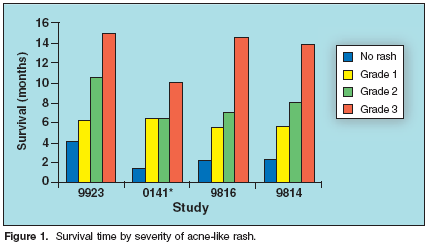With Cetuximab and Erlotinib,Rash Correlates With Survival
This special supplement toOncology News International presents11 reports on novel agents targetingHER1/EGFR, VEGF, and HER2/neu receptorsin the treatment of non–small-cell lung cancer,colorectal cancer, mesothelioma, andglioblastoma. The reports summarizeselected presentations from theAmerican Society of Clinical Oncology (ASCO)39th Annual Meeting and a satellitesymposium held in conjunction with ASCO.
CHICAGO-Separate reviewsof data from multiple phase II trialswith novel agents cetuximab (Erbitux)and erlotinib (OSI-774, Tarceva) haveconcluded that patients who developedan acne-like rash lived longerthan those who did not, and that patientswith more severe rash lived longerthan patients with mild rash.In presenting their analyses at the39th Annual Meeting of the AmericanSociety of Clinical Oncology (ASCO)(ASCO abstracts 786 and 817), theinvestigators suggested that rash couldbe a biomarker for response to HER1/epidermal growth factor receptor inhibitors(HER1/EGFR). A recent journalarticle also identified rash as a predictorof response to gefitinib(ZD1839, Iressa), a third agent thattargets EGFR (Cohen et al: J Clin OncolMay 15; 21(10):1980-1987, 2003).The big question is whether theobservation will prove clinically useful.Both sets of researchers presentingdata speculated that the optimal doseof HER1/EGFR inhibitors could belinked to an optimal degree of rash ineach patient. They cautioned, however,that the rash might be a surrogatefor another factor involved in the response."It could mean that a strategy forimproving the effectiveness of the drugcould be to dose to a certain level ofrash; that some people may need moredrug and be able to tolerate more drugin order to escalate to a degree of sideeffect that will be commensurate witha higher degree of activity," LeonardB. Saltz, MD, of Memorial Sloan-KetteringCancer Center, told ONI.

Alternative Hypothesis
"An alternative hypothesis wouldbe that patients have particular polymorphismsof the epidermal growthfactor receptor that make them morevulnerable to toxicity and their tumorsmore vulnerable to the attack bythis particular drug," Dr. Saltz continued."We really don't know if thisobservation will have a therapeuticmeaning or not," Dr. Saltz said.Gary M. Clark, PhD, senior directorof biostatistics and data managementof OSI Pharmaceuticals, Inc.,compared the rash to tumor flares experiencedby breast cancer patientstreated with tamoxifen in the early1980s. Some women asked to be takenoff the new drug because of pain andvaginal dryness, but it turned out to bea sign the drug was working, Dr. Clarksaid. He is the lead investigator of theerlotinib analysis."The question, of course, is can wedo anything about this? Can we takeadvantage of it?" he said to ONI. "Is itpossible to increase the dose in somepatients and achieve a better clinicaloutcome?" He said that OSI has alreadystarted a dose-to-rash study.Review of Previous Trials
Dr. Saltz and Dr. Clark each mineddata from previously reported phaseII trials. ImClone Systems Incorporatedof Somerville, New Jersey, develop-er of cetuximab with Bristol-MyersSquibb Oncology, participated in thecetuximab study.Dr. Saltz reviewed trials evaluatingcetuximab:
- with irinotecan (CPT-11,Camptosar) in 120 patients with colorectalcancer;
- alone in 57 colorectal cancerpatients;
- with cisplatin in 79 squamouscell cancer of the head and neck patients;and
- with gemcitabine (Gemzar) in41 pancreatic cancer patients.
About 75% of patients developed arash. In all four studies, patients withno rash had the shortest median survival,while patients with grade 3 rashlived longest (see Figure 1). In patientswith pancreatic cancer, for example,the range for length of survival wentfrom 2.3 months with no rash to 13.9months with grade 3 rash.So far the rash has been treatable aswell as controllable with dose adjustment,Dr. Saltz said. He voiced a concern,however, that the finding "impliesa relatively modest therapeuticwindow whereby we're going to haveto accept the skin toxicity to get whatwe want out of the drug."
Relationship to Outcome
Dr. Clark reviewed three erlotinibstudies.
- Among 57 patients with refractorynon-small-cell lung cancer(NSCLC), 75% developed rash.
- Among 115 patients with advancedsquamous cell cancer of thehead and neck, 70% developed rash.
- Among 34 patients with advancedovarian cancer, 82% developedrash.
No patient without a rash respondedto therapy. Pooled data from allthree studies showed median survivalof 44 days without rash, 67 days withgrade 1 rash, and 95 days with grades2/3 rash."I looked at every possible pretreatmentcharacteristic I could find. Someof them correlated with outcomes, butnone of them changed the relationshipbetween rash and outcomes," Dr.Clark said.A co-author of the erlotinib analysis,Roman Perez-Soler, MD, of MontefioreMedical Center, Albert EinsteinCollege of Medicine, New York,raised the rash issue at "Targeting CriticalPathways in Oncology" a post-ASCO, industry-sponsored satellitesymposium. Nine studies with severalhundred patients have shown a strongrelationship between rash and survivalwith agents targeting HER1/EGFR,according to Dr. Perez-Soler. Andthere is a consistant trend betweenhigher grades of rash and longer survival."Should we adjust doses to grade1/2 rash?" he asked rhetorically. "Wedon't have the answer today; butobviously we should pay attention tothis."